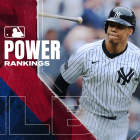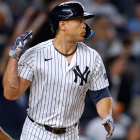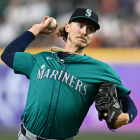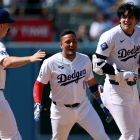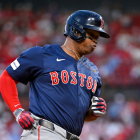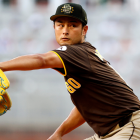 |
| Heath Hembree could have the strongest right-handed relief arm in the Giants organization (USAT Sports Photos) |
Prior to the start of the season, we'll highlight a few players in each team's minor-league system to let you know which players you should be paying attention to throughout the year. These aren't meant to be comprehensive top-prospect lists but should provide a look at some key players within each team's organization.
More Tigers spring training content | Camp report | Likes, dislikes | Team preview
Unsurprisingly, the World Champion Giants won't be relying on prospects too much in 2013. But the Giants can credit much of their brilliant run the past three years to the excellent scouting, drafting and development of prospects by GM Brian Sabean and his team. Buster Posey, Matt Cain, Tim Lincecum, Madison Bumgarner, Brandon Belt and Pablo Sandoval make up just part of the Giants' excellent homegrown core, and it's this ability to build the organization from the bottom up that will keep the Giants competitive going forward.
2013 Impact Player
Heath Hembree
The Giants bullpen has a fine anchor in Sergio Romo, but life beyond Brian Wilson has left the Giants lacking depth. As such, Hembree, a potential closer of the future, could easily see his first chance in the major league this season.
Hembree reached Triple-A last season and struggled for the first time in his career; his 8.5 K/9 marked the first time in his career Hembree failed to strike out a batter per inning, and his control struggles (4.7 BB/9) limited him to just a 4.74 ERA. However, Hembree struggled with a tendon injury last year, and after the Giants sent him to the Arizona Fall League, he rediscovered the 93-96 MPH fastball that keyed his success in the lower minors.
Hembree pairs the fastball with with a mid-80s slider, the classic right-handed reliever repertoire, and he's used it to strike out 12 batters for every nine he's faced since beginning his professional career. The Giants may only break camp with three right-handed relievers (Romo, Santiago Casilla and George Kontos), and only Casilla can match Hembree's velocity. Chances are, the Giants will need another righty in the bullpen at some point this season, whether due to ineffectiveness or injury, and Hembree is likely to be the guy if he can show that his struggles last year were a fluke and not his true talent.
Future Star
Kyle Crick
The Giants themselves have been comparing Crick to Matt Cain since the Giants popped Crick in the first supplemental round of the 2011 MLB Draft. He's young -- just 20 years old -- and raw -- he didn't begin pitching seriously until late in his high school career -- and yet he is handling professional baseball extremely well early on. Crick posted a 2.53 ERA at Low-A Augusta over 22 starts in 2012 and only improved as the season went on. The 6-foot-4 righty recorded a shiny 1.91 ERA.
With such improvement so quickly for somebody with as little pitching experience as him is a clear signal of huge potential. The next step for Crick is to tighten up the control, as he walked 5.4 batters per nine innings. He was able to blow hitters away with his mid-90s fastball -- 99 MPH at its peak -- and a 10.3 K/9 will help a pitcher get out of a multitude of jams. But Crick will have to be more dialed into the strike zone as he progresses up the organizational ladder -- better hitters will make him pay for allowing so many baserunners.
Given where Crick already is and how much time he has to develop until he reaches the majors, he's in fantastic position to make a huge impact in the Giants' rotation a few years down the line.
Wild Card
Gary Brown
Brown was an intriguing player when the Giants popped him in the first round of the 2010 MLB Draft. His blinding speed was clearly the top asset, but impact outfielders -- even center fielders -- in today's league typically need to hit for power to have first-round value, and at six feet even and 185 pounds, Brown's frame is not one typical of the slugger. It didn't matter for Brown in 2011, his first full professional season, as he slaughtered California League pitchers to the tune of a .336/.407.519 line with 61 extra-base hits in 559 at-bats (24 doubles, 13 triples and 14 home runs).
But the California League is among the friendliest for hitters in American professional baseball, and as such his 2012 season in Double-A stood as a much tougher test. Brown wasn't bad at Double-A Richmond, but his power certainly didn't sustain its 2011 levels. Brown posted a .279/.347/.385 line with 41 extra-base hits in 538 at-bats. It was more about slapping doubles (32) than mashing home runs (7) for Brown, and as such he couldn't even get over a .400 slugging percentage, a mark he'll likely have to clear to be an above-average player in the outfield.
As such, 2013 in Triple-A could be a big year for Brown. The Pacific Coast League is another hitter-friendly league and another chance to show he has enough power to stick in the outfield. The speed is not a question -- he stole 83 bases over the past two seasons -- and his defense in center field should be acceptable. With Angel Pagan around for another four years, Brown will have plenty of time to develop his bat. If even a little power shows up, he can be a big asset in the outfield for San Francisco.












